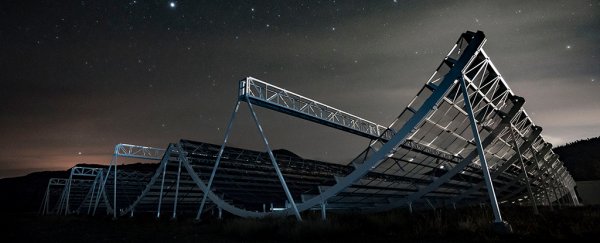The final piece of the brand new Canadian Hydrogen Intensity Mapping Experiment (CHIME) telescope has been put in place, which means it can start mapping the Universe in greater depth than we've ever seen before.
CHIME's main purpose is to try to measure the composition of dark energy, that most mysterious form of energy that astronomers think is helping the expansion of the Universe to accelerate.
On top of that rather substantial job, CHIME is also going to be helping in the detection of gravitational waves and the analysis of the fast radio bursts that occasionally reach our planet from the depths of space, and which have yet to be fully explained.
"With the CHIME telescope we will measure the expansion history of the Universe and we expect to further our understanding of the mysterious dark energy that drives that expansion ever faster," says one of the CHIME team, Mark Halpern from the University of British Columbia in Canada.
"This is a fundamental part of physics that we don't understand and it's a deep mystery. This is about better understanding how the Universe began and what lies ahead."
 Credit: CHIME
Credit: CHIME
Having taken seven years to build, CHIME is made up of four 100-metre (328-foot) long half-pipe structures and has no moving parts. It uses the Earth's movement to take snapshots of the Universe as the sky rolls by overhead.
Specifically, CHIME is going to be measuring the location of hydrogen gas in deep space, the most common element in the Universe – by getting a picture of these hydrogen structures, scientists can also work out vast distances, and come up with a 3D map of the cosmos that's more detailed than any that we've put together so far.
You won't get any pretty pictures of spiral galaxies from CHIME, but the colour of the light emitted by the mapped hydrogen structures will also feed into calculations about how the Universe has grown over billions of years.
And if we can understand more about how that expansion has worked itself out, we might be able to learn more about what's causing it: dark energy, perhaps.
The radio waves that CHIME measures are very weak, which is why incredibly sensitive instruments are needed to detect them. To put it into perspective, the amount of energy CHIME will collect in a whole year is the same as the energy gained by a paper clip falling from a desk to the floor.
At the other end of the magnitude scale, the data CHIME crunches through in real time is the same as the amount of data flowing through all the mobile networks of the world at any given moment.
To make sense of all that data, the systems underpinning CHIME have to compress that data stream by a factor of 100,000 just to be able to save it to disk. Components similar to those used in smartphones and graphics cards help to make up CHIME.
"CHIME 'sees' in a fundamentally different way from other telescopes," explains one of the CHIME astronomers, Keith Vanderlinde from the University of Toronto. "A massive supercomputer is used to process incoming radio light and digitally piece together an image of the radio sky."
You can expect to hear much more about CHIME in the coming months and years as it gets to work charting the dimensions of deep space and trying to gather more data about the parts of the Universe that have puzzled experts for years.
The three areas that it's concentrating on – the history of the Universe, the nature of distant stars, and the detection of gravitational waves – are described as the "three frontiers of modern astronomy" by the CHIME team.
"We think that this and similar experiments of super-deep cosmological measurements are going to formulate an important part of the next 10 or 20 years in astronomy," says Halpern.
The CHIME team has also put together a video on the telescope, which you can see below:

